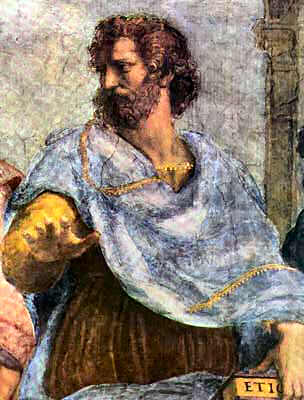How Aristotle’s 10 Categories Relate to Eucharistic Transubstantiation
In the Catechism we learn that in the miracle of transubstantiation, the substances of bread and wine “transubstantiate” into the substance of Christ. What remains are the accidents. Here, accident refers to what is incidental and not essential.
Most catechized Catholics are able to explain that in the Eucharist, the substance of bread and wine become the substance of Christ, yet the incidental features of bread and wine (color, taste, smell, weight, size, etc.) remain.
According to Aristotle, there are ten categories by which we can predicate. When we say, “This is ________” we can fill in the blank in ten ways. I can point at a dog and say, “This is ___________” and answer in ten ways. For example, I could point to dog and say, “This thing is a dog,” or I could say, “This thing is black” or I could say “This is 25 pounds” or I could say “This thing is on the floor.” All would be true.
However, when I say “This thing is a dog,” I speak of its substance. When I say, “This thing is black,” I speak of its accidents.
Aristotle says that in the 10 ways that we predicate, one is to speak of the substance, the other nine ways are accidents – things that can change or are non-essential. So then, substances are unique in that they are independent. The other nine categories are “accidental.” These nine categories each depend on substances and can’t exist on their own, e.g. redness, double, smallness, etc.
Let’s take a look at these 10 Categories:
1. Substance (ousia, “essence” or “substance”). Substance is defined as that which neither can be predicated of anything nor be said to be in anything. Hence, this particular man or that particular tree are substances. Later in the text, Aristotle calls these particulars “primary substances”, to distinguish them from secondary substances, which are universals and can be predicated. Hence, Socrates is a primary substance, while man is a secondary substance. Man is predicated of Socrates, and therefore all that is predicated of man is predicated of Socrates.
2. Quantity (poson, “how much”). This is the extension of an object, and may be either discrete or continuous. Further, its parts may or may not have relative positions to each other. All medieval discussions about the nature of the continuum, of the infinite and the infinitely divisible, are a long footnote to this text. It is of great importance in the development of mathematical ideas in the medieval and late Scholastic period.
3. Quality (poion, “of what kind or quality”). This is a determination which characterizes the nature of an object.
4. Relation (pros ti, “toward something”). This is the way in which one object may be related to another.
5. Place (pou, “where”). Position in relation to the surrounding environment.
6. Time (pote, “when”). Position in relation to the course of events.
7. Position (keisthai, “to lie”). The examples Aristotle gives indicate that he meant a condition of rest resulting from an action: ‘Lying’, ‘sitting’. Thus position may be taken as the end point for the corresponding action. The term is, however, frequently taken to mean the relative position of the parts of an object (usually a living object), given that the position of the parts is inseparable from the state of rest implied.
8. State or habitus (echein, “to have”). The examples Aristotle gives indicate that he meant a condition of rest resulting from an affection (i.e. being acted on): ‘shod’, ‘armed’. The term is, however, frequently taken to mean the determination arising from the physical accoutrements of an object: one’s shoes, one’s arms, etc. Traditionally, this category is also called a habitus (from Latin habere, “to have”).
9. Action (poiein, “to make” or “to do”). The production of change in some other object.
10. Affection (paschein, “to suffer” or “to undergo”). The reception of change from some other object. It is also known as passivity. It is clear from the examples Aristotle gave for action and for affection that action is to affection as the active voice is to the passive. Thus for action he gave the example, ‘to lance’, ‘to cauterize’; for affection, ‘to be lanced’, ‘to be cauterized.’ The term is frequently misinterpreted to mean a kind of emotion or passion.
Here’s a chart:
| Categories | Aristotle’s Term | Greek | Examples |
|---|---|---|---|
| Substance/Essence | “substance”
“this” “what-it-is” |
ousia
tode ti ti esti |
man, horse
Socrates “Socrates is a man” |
| Quantity | How much | poson | four-foot, five-foot |
| Quality | What sort | poion | white, literate |
| Relation | related to what | pros ti | double, half, greater |
| Location | Where | pou | in the Lyceum, in the marketplace |
| Time | When | pote | yesterday, last year |
| Position | Being situated | keisthai | lies, sits |
| Habit | Having, possession | echein | is shod, is armed |
| Action | Doing | poiein | cuts, burns |
| Passion | Undergoing | paschein | is cut, is burned |
Remember, good theology always depends on good philosophy. The root of every heresy is an incorrect philosophical principle applied to divine revelation.
Please also explore Taylor’s books about Catholicism at amazon.com.
What to Watch Next
SHOP THE TAYLOR MARSHALL STORE
Dive Deeper

GET CONFIDENT IN YOUR FAITH
Explore the fascinating world of Catholic teachings with Dr. Marshall. Together you’ll unpack the brilliant answers the Church gives to tough questions about the Faith. The best part: you go at your own pace. Start this exciting journey today.


 >
>



